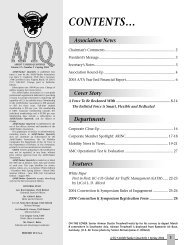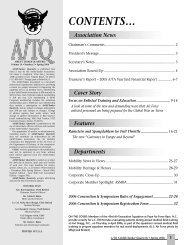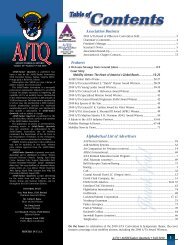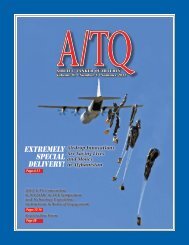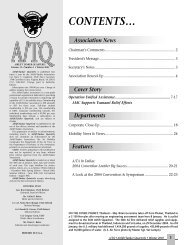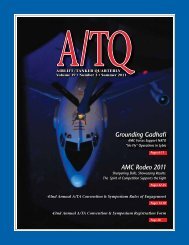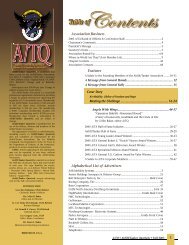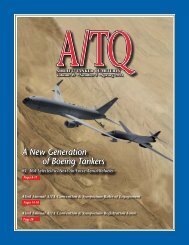1) ATQ Fall 2003 for pdf - Airlift/Tanker Association
1) ATQ Fall 2003 for pdf - Airlift/Tanker Association
1) ATQ Fall 2003 for pdf - Airlift/Tanker Association
You also want an ePaper? Increase the reach of your titles
YUMPU automatically turns print PDFs into web optimized ePapers that Google loves.
Though the squadron is being drawn down to make way <strong>for</strong> the<br />
C-17 Globemaster III, its operations tempo has been on the rise. The<br />
Iraqis are free and the KC-10s Extenders have returned home, and<br />
now the heavy lifting begins -- the Starlifter way.<br />
“We’ve been getting smaller every day <strong>for</strong> the last five months, but,<br />
if anything, our operations tempo has been going up,” said Lt. Col. Eric<br />
Wydra, 6th AS commander. “We really are doing more with less.”<br />
The KC-10s were used heavily as cargo haulers during the combat<br />
portion of the war, but since the reconstruction phase has begun,<br />
Capt. Jeffrey Fagan (left), a<br />
C-17A Globemaster III pilot<br />
and Staff Sgt. Rene Delarosa,<br />
a C-17 loadmaster, both from<br />
the 17th <strong>Airlift</strong> Squadron at<br />
Charleston Air Force Base,<br />
S.C., help hang American flags<br />
along the walls of their aircraft<br />
while en route to an airdrop<br />
location over Afghanistan<br />
in support of Operation<br />
Enduring Freedom. (U.S. Air<br />
Force photo by Master Sgt.<br />
Keith Reed)<br />
the C-141s have taken on a bigger role and are now flying a greater<br />
number of missions.<br />
Officials at the Air Mobility Command’s <strong>Tanker</strong>/<strong>Airlift</strong> Control<br />
Center task about 85 percent of the available Starlifters here daily.<br />
This is approximately 20 percent higher than the current KC-10<br />
tasking level, relative to the number of available aircraft here.<br />
In fact, the Starlifters are the only McGuire aircraft going into Iraq<br />
right now. Their “Baghdad Express” lands at Baghdad International<br />
Airport almost daily.<br />
“Baghdad Express” is the term given to the C-141 re-supply run<br />
from Ramstein Air Base, Germany, to Baghdad. Two McGuire aircraft,<br />
two active-duty aircrews and one Reserve crew from the 514th Air<br />
Mobility Wing are staged in Germany flying daily missions into either<br />
Baghdad or Kuwait, said Wydra.<br />
“Our job is to re-supply the ground troops who’ve established a<br />
pretty big presence there,” said Master Sgt. Bill Marley, a C-141 flight<br />
engineer.<br />
The “Baghdad<br />
Express” began<br />
on May 14 when<br />
an eight-person,<br />
a u g m e n t e d ,<br />
active-duty crew<br />
took flight over<br />
European air<br />
toward the area of<br />
responsibility.<br />
“It was uneventful<br />
C-141 Starlifters taxi down the runway at McGuire<br />
AFB, New Jersey. Although the 6th <strong>Airlift</strong> Squadron<br />
is being drawn down to make way <strong>for</strong> the C-17<br />
Globemaster III, its operations tempo has been on<br />
the rise. (U.S. Air Force photo by John Sidoriak Jr.)<br />
through Europe<br />
until we hit<br />
Turkish airspace,”<br />
said Lt. Col. Keith<br />
Michel, a C-141<br />
pilot examiner. “At<br />
that point, all the rules changed. We no longer had normal air traffic<br />
control coverage of things like altitudes, airways, speeds or routes.”<br />
They made their way along ‘parkways, avenues and highways’ in<br />
the sky using the “see and avoid” navigation technique into Iraq.<br />
Once there, they had to use their threat-avoidance arrival and<br />
departure procedures to do a tactical approach – coming in at a high<br />
altitude and rapidly descending to the airfield – in order to avoid<br />
threats posed by surface-to-air missiles and anti-aircraft artillery.<br />
“We had to watch out <strong>for</strong> generally happy Iraqis who sometimes<br />
shot random shots into the air, too,” said Marley, who was on that<br />
first trip into Iraq.<br />
Cargo runs make up about 95 percent of the C-141s’ trips into Iraq,<br />
resulting in more than 1 million pounds of cargo getting to the troops<br />
who need it.<br />
Other flights include medical evacuation missions. One mission<br />
carried a belly-full of wounded troops, including two seriously injured<br />
Army soldiers suffering from multiple shrapnel wounds caused by a<br />
rocket-propelled grenade.<br />
“The whole idea of someone shooting someone else … I’ve never<br />
seen that be<strong>for</strong>e. I’d never been that close,” said Capt. Josh Rice, 6th<br />
AS co-pilot.<br />
While some 6th AS crews are helping save lives and support<br />
combat operations, others are maintaining their routine channel and<br />
re-supply missions or unique opportunities. These include a mission<br />
to Kazakhstan supporting the National Aeronautics and Space<br />
Administration, repatriation missions of WWII aviators’ remains,<br />
South American counterdrug missions, worldwide embassy support<br />
missions, presidential/vice presidential movement support, and<br />
Thunderbird aerial demonstration team-support missions.<br />
“From where the sun rises to where the sun sets, we’re there,” said<br />
Tech. Sgt. Karl Eckberg, a loadmaster in the 6th AS.<br />
“They’re flying twice as many flying hours now as they did this<br />
time last year, they’re doing it with fewer people and they’re doing it<br />
all with smiles on their faces,” said Wydra.<br />
KC-10 Extender<br />
Life ‘Booms’ <strong>for</strong> KC-10 Airman<br />
by Senior Airman Rachel Bush<br />
380th Air Expeditionary Wing Public Affairs<br />
At midnight in early September, Airman 1st Class Katherine Monke<br />
looked out over Afghanistan from her KC-10 Extender. She said one<br />
of the best things about her job was just sitting up in the cockpit.<br />
“I think to myself, ‘I wonder what my friends back home are doing’<br />
Then I look down and realize I am flying over Baghdad or Afghanistan<br />
or one of the hundreds of other places I have flown over,” Monke said.<br />
“I know this is something they will never get to experience, and this<br />
is something that I will never <strong>for</strong>get.”<br />
Monke, the tanker’s boom operator, will usually refuel between<br />
one and four planes, but she stayed incredibly busy on this 12-hour<br />
mission Sept. 5, making 18 refuelings.<br />
Monke chose to be a boom operator after her recruiter suggested<br />
she be a flier, since she had a great desire to travel and see the world.<br />
“It is definitely a lot of fun. I am happy with my decision,”<br />
she said.<br />
Monke has been in the Air Force <strong>for</strong> almost two years, with training<br />
taking up the better part of one of those years. This is her first<br />
deployment.<br />
Four hours into the mission, Monke was called to her post to make<br />
the first boom connection. A-10 Thunderbolt IIs and F-16 Fighting<br />
Falcons were her customers that night.<br />
“A-10s are the hardest to refuel because they fly so much slower<br />
than the KC-10. The KC-10 has to drastically slow down <strong>for</strong> them to<br />
catch up,” Monke said.<br />
“Refueling an A-10 makes my job look a lot harder than it is. Really,<br />
I never have to work this hard to get someone connected,” she said as<br />
the A-10 pilot backed away <strong>for</strong> his fourth attempt at a connection.<br />
Although the situation can be frustrating, Monke remained calm as<br />
the A-10 came in closer.<br />
A/TQ •<strong>Airlift</strong>/<strong>Tanker</strong> Quarterly • <strong>Fall</strong> <strong>2003</strong><br />
23




